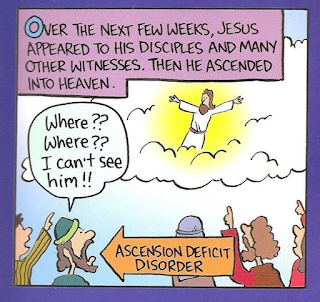Ascension: The God Who Completes
(Credit to Inherit the Mirth)
Sadly
underemphasized but monumentally important Jesus’ ascension saves our faith
from becoming “merely” Easter-centered (as if Jesus work for us is over) or “merely”
Pentecost-centered (as if the Spirit’s work is somehow other or different from
Jesus’). The ascension completes Jesus’
-journey
from heaven to earth and back to heaven
-work
of salvation from womb to tomb to heavenly throne room
-achievement
of God’s eternal purpose
Thus, the God we
meet in the face and work of Jesus is the God who completes all he has desired
and worked for. No stronger affirmation of divine faithfulness is available or
needed.
Mention of
heaven and Jesus flying through the sky on way there account for much of the embarrassment
and perplexity many feel about this part of Jesus’ story. Though the USSR
cosmonaut Yuri
Gagarin is famously reported to have said that on his trip into space in 1961
that he looked around and didn’t see God up there, had he been there on
Ascension Day would he have seen Jesus zip by on his way to heaven? Maybe it
was one final miraculous “good-bye” to earth from Jesus capping off his life of
miracles? Or we can simply write it off as a symbolic expression of some truth or
other about Jesus that didn’t really happen.
explains,
“The biblical notion of heaven is not of a
place far away ‘way beyond the blue’. Nor is it simply, as some have said in
reaction to that older notion, a state of mind or heart which some people can
attain here and now. Heaven is God’s space, which intersects with our space but
transcends it. It is, if you like, a further dimension of our world, not a
place far removed at one extreme of our world. It is all around us, glimpsed in
a mystery in every Eucharist and every act of generous human love. We are
reminded of it by the beauty of the created order, which in its very transience
points beyond itself to the fuller beauty which is God’s own beauty, and which
he intends one day to bring to birth, as we say so frequently, ‘on earth as it
is in heaven.’”
Heaven and earth
in creation are fully interlocked and integrated spheres. Human rebellion tragically
separated or decoupled these spheres. Not in space however, though no less in
reality. Jesus’ ascension is a narrative rendering of the completion of the
reunification of heaven and earth, God’s realm and the human realm. In him
heaven and earth are again brought together under God as he always intended.
The ascension
also tells us that God’s work of salvation through Jesus is finished, complete,
and crowned with glory as the Son takes his seat on the throne of heaven to
take up his rule of “heaven and earth” (Mt.28:18-10). Wright, again, explains
“. . . the ascension is the affirmation
that God has taken that fully human, deeply and richly human being Jesus, and
has embraced him to himself within his own dimension, his own space, making him
indeed Lord of the world. God always intended that his human creatures should
inherit the world, the created order, to rule over it with wisdom and
gentleness, to bring it order and to enhance its beauty. In the ascended human
Jesus that vision is in principle realized.”
This means at
least the following:
-by virtue of his perfect sacrifice,
Christ is the perfect advocate we have in God’s presence (Rom.8:34; 1 Jn. 2:1;
Heb.7:25),
-he gives us his Spirit as the mode of his
presence and source of his blessings and gifts to us.
We cannot stress
the importance of Christ ascended as both “fully human and fully divine.” If,
as we tend to do, imagine him as returning to his divinity and leaving his
humanity behind, we effectively dehumanizing him, and rob his ascension of any transformative
significance for us. Thomas F. Torrance unpacks
this for us:
“Is this not why our churches today often
appear so inhospitable because they have lost something, as it were, of the
flesh and blood of Jesus Christ? It is only too easy for a church to
become an inhuman institution... [operating] with a docetic Christology [a
heresy that denies the humanity of Jesus].
“....The teaching of the
New Testament [is] that the Church is the Body of the living Christ... [And]
here we are concerned very much with the Humanity of Jesus. "We are
members of his body, of his flesh and of his bones" (Eph. 5.30). This is the strongest possible
emphasis upon the fact that in the resurrection of Christ and in the Church's
participation in Him the purpose of God in creation is brought to its
fulfillment. This fulfillment is no abrogation of its creatureliness but on the
contrary a restoration of its creaturely reality which had been impaired by
sin.... This means that our creaturely humanity is not transcended or
transmuted or trans-substantiated but is fully substantiated as creaturely
humanity in the creature-Creator relation” (http://thesurprisinggodblog.gci.org/2019/05/jesus-ascension-what-does-it-mean-for-us.html?utm_source=feedburner&utm_medium=email&utm_campaign=Feed%3A+gci%2FzGUy+%28The+Surprising+God%29).
(to
be continued)

Comments
Post a Comment